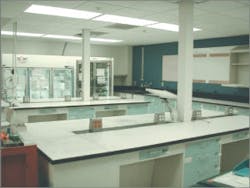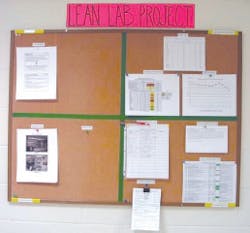Clinical
laboratories play a key role in the healthcare industry, providing
caregivers critical information they need to diagnose and treat
patients. By using LEAN methods, hospitals are making significant
improvements for the benefit of patients, employees, physicians, and
communities. Fewer handoffs and increased standardization are key
factors in reducing medical errors and improving patient safety.
The Committee on Quality of Healthcare in America and the Institute of
Medicine estimate nearly 100,000 patients die each year from preventable
medical errors. Additionally, a report from the United Kingdom National
Health Service states that one-third of lab tests are repeated
unnecessarily, because results were misplaced, often in the paper “jungle.”
Good Samaritan Hospital (GSH) in Kearney, NE, learned that it is
possible, through LEAN processes, to simultaneously improve patient safety,
provide better care and quality, and still lower costs. The hospital's
in-house diagnostic laboratory performs more than 500,000 billed-tests
annually. Hospital leaders elected to start the LEAN initiative in the lab
for three reasons. First, the lab is a critical path to all patient care.
Second, the lab project could make an impact quickly. Finally, the speed and
accuracy of lab results are not only a performance measure but also a key
safety factor.
5S principles
- Sort: Clearing the work area
- Set in order: Designating locations
- Shine: Cleanliness and workplace appearance
- Standardize: Everyone doing things the same way
- Sustain: Embedding LEAN philosophy into the culture
Healthy results
The hospital realized more than $300,000 in
annual savings, a $90,000 inventory reduction, and 35% faster test
results after the LEAN project. Prior to launching the project, Good
Samaritan leaders visited another hospital to see the LEAN methods in
action and how a new culture of standardized, value-based processes
resulted in better patient care. Senior leaders learned the importance
of engaging directors throughout the hospital.
“Leadership must provide the continued financial and moral support for
LEAN to be successful,” says Peggi Jenkins, director of process improvement,
who coordinates LEAN process improvements at GSH. “If you do not have
internal LEAN expertise, outside expertise is critical to help your team
focus and integrate LEAN processes. Our LEAN partner, TechSolve, enlisted
many of our stakeholders throughout the hospital,” Jenkins explains.
Unlike most hospitals that track results from the time the request hits
the lab, Good Samaritan wanted to track the entire cycle — from the time the
lab test was ordered until the completed results were released to the
physician. The goals were not only to optimize lab productivity, workflow,
and staff satisfaction, but also to improve patient care and safety.
“Keeping patients front and center is our team's primary mission,” Jenkins
says. “Together our team developed the theme 'One Patient, One Process, One
Team' and set the goal of reducing turnaround time (TAT) from order to
verify. The key mind-set was to realize that each order was an individual
patient — not just a specimen.”
critical to help your team focus and integrate LEAN processes.
Lab staff and representatives from key departments formed a
cross-functional team. The team created a value-stream map of the workflow
and inventory processes starting from the physician order to verified
results. The team examined processes, developed workflow diagrams, and
detailed plans for improvements. They eliminated steps that did not add
value and identified areas with the greatest room for improvement. Next, the
group reduced variations to minimize errors and created new standardized
processes.
Before the LEAN initiative
The old configuration was typical of many labs today,
compartmentalized with specimen receiving, chemistry, and hematology.
Staff gathered specimens from a pneumatic tube station and took them to
a separate receiving room. This distance limited both line of sight and
communication, and also led to larger batch sizes. Phlebotomy was
isolated across the hall from the rest of the lab. Additionally, fixed
cabinets limited flexibility. Phlebotomists differed with their work
styles and tools. Some used trays, while others used carts. Lab
supplies, equipment, and other materials were stored in any open space.
The poor design, along with lack of organization and standardization,
resulted in inefficiency and redundancy.
LEAN lab layout
The team developed three layout options for the new lab design and
compared each to their guiding principles to find the best solution.
Additionally, cardboard cutouts replicated options for workflow to
ensure expensive equipment was only moved once, which allowed techs to
keep working. These steps minimized the impact to patient care and
safety as well as daily operations. To complete the redesign in less
than a month, it was essential for all departments to be aligned.
Before LEAN implementation
After LEAN redesign
Specimen receiving relocated into the laboratory, and all specimens were
now machine ready, leading the way for new smaller centrifuges, which
reduced batch size and cycle time. Cycle time was reduced from nine to13
minutes down to three to four minutes. Batch sizes were also reduced from
five to 10 specimens down to three to five specimens. This drastically
improved timeliness and workflow — key elements in LEAN process design.
The old compartmentalized layout gave way to a circular and mobile bench
configuration. This new design enabled one technician to run the core tests
in the laboratory. The tech now has one pick-up point with machine-ready
specimens. A secondary core was designed and located nearby for longer, more
intensive, and less frequent tests. The blood bank was moved closer but
stayed in a discreet area for safety reasons. Refrigerators were moved
closer to the core, and electrical and data cables were dropped from
overhead to improve flexibility and allow for future growth.
individual patient — not just a specimen.
Phlebotomy was relocated in the laboratory and given standard mobile
carts with detachable trays. The floor was labeled with a specific location
and number for each cart. This increased accountability for stocking the
carts and keeping them standardized, which also reduced time needed at the
start of each shift.
To drive down inventory and associated holding costs, the inventory
process was redesigned with the use of Kanban cards. These visual cards
provide details such as item, bar code, minimum and maximum levels, as well
as bin, shelf location, and re-order quantity. The improved inventory
process has reduced inventory levels and costs, while essentially reducing
the time spent each week by technicians ordering supplies.
GSH found that with any LEAN project, standardization is critical to set
expectations and improve both productivity and quality. Standards, however,
must be written in plain English, with little room for interpretive error.
Ongoing communication is essential to sustaining a LEAN culture. To help
drive communication, GSH has meetings, e-mails, banners, and a visual
communications board provide regular updates, reinforcing consistent
messages to reach individuals with a variety of learning styles. The board
organizes all current data about the project, including patient-satisfaction
scores.
Challenges
LEAN experts estimate that only 15% to 20% of any
LEAN project is technical, while the majority of the effort focuses on
organizational culture and readiness. “A LEAN lab has to be experiential
for every team member to embrace the concepts and see the benefits,”
Jenkins explains.
Good Samaritan's greatest challenge with implementation was overcoming a
culture of departmentalization. Staffers with 20 to 30 years of service had
become accustomed to a particular work style. GSH learned that staffers may
require up to 26 repetitions to integrate process changes behaviorally.
Education needs to start long before launching a LEAN project. “We talked
to our staff for nine months about different aspects of LEAN,” says Steve
Loveless, vice president of ancillary and support services at GSH. “We used
a system of integrated and consistent communication to bring our team
along.”
Improved quality and patient care
There are two foundations for
patient wellness — safety and quality. Good Samaritan's LEAN lab project
resulted in patients getting results 35% faster from the time of order
through result verification. This is critical, especially in the
emergency department, where the average and standard deviations for cell
blood counts (CBC) were reduced 55% and 68% respectively.
GSH's overall TAT metric results
- 35% improvement in turnaround time (TAT) across top eight
critical/high-volume tests - 49% reduction in variation of TAT across top eight critical/high-volume
tests - 50% increase in percent of tests verified by 7 a.m. (start of morning
rounds) - Patients surveyed rated the lab nine or 10 – an overall improvement from
70% to 78% - Productivity improved from 57th percentile to 30th percentile among
Catholic Health Initiatives MBOs - Drastically improved ordering processes created visibility of true
inventory needs - One-time inventory reduction of $90,000
- Estimated $300,000 annual bottom-line impact
Additionally, the lab significantly improved the percent of tests
verified in time for morning rounds by 50%. The faster response time now
allows clinicians to make safer and more accurate judgments to better
determine the proper care path.
Patient satisfaction scores went from 75% to greater than 85% for
likelihood to recommend for outpatient blood draws. Overall recommendation
scores for the hospital improved from 70% to 78%, with patients giving GSH a
nine or 10 on a 10-point scale.
Key LEAN lessons
- It is not possible to over-communicate.
- Continuously focus on improvement.
- Engage all facets of an organization, not just a core team.
- Actions speak louder than words.
- Ideas flow from the bottom up.
- Be respectful to every individual. Listen to and seriously consider
their ideas. - A feedback loop is critical to overcome challenges.
- Staff must be accountable to achieve success.
- Cross-functional alignment is critical.
LEAN terms, performance metrics, progress reports, daily updates, and
problem-solving log.
High-quality healthcare puts patient safety first, and through LEAN
initiatives, laboratory professionals can become fully integrated partners
in providing quality care and ensuring patient safety.
Jason Coons is a Six Sigma Black Belt and Healthcare Solutions
program manager for TechSolve, a LEAN production and process management
consultation company, in Cincinnati, OH. He holds a certification in LEAN
Healthcare from the University of Tennessee and a BS in Industrial
Engineering from the University of Cincinnati.
Harold Courtois, director of Clinical Laboratory for Good Samaritan
Hospital, Kearney, NE, has 35 years of laboratory experience and a master's
degree in Management from Friends University in Wichita, KS, an MLT(ASCP)
degree, and a BA in Biology from Southwestern College.




